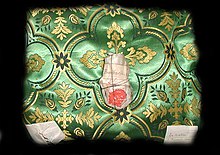
Back Рэлікварый BE Таксидиотска кутия Bulgarian Reliquiari Catalan Relikviář Czech Relikviegemme Danish Reliquiar German Relikvujo EO Relicario Spanish Relikviaar ET Erlikia-ontzi EU


A reliquary (also referred to as a shrine, by the French term châsse, and historically also referred to as a phylactery[1]) is a container for relics. A portable reliquary may be called a fereter, and a chapel in which it is housed a feretory or feretery.[2]
Relics may be the purported or actual physical remains of saints, and may comprise bones, pieces of clothing, or some object associated with saints or with other religious figures. The authenticity of any given relic is often a matter of debate; for that reason, some churches require documentation of a relic's provenance.
Relics have long been important to Buddhists, Christians, Hindus, and to followers of many other religions.[3][4][5] These cultures often display reliquaries in shrines, churches, or temples to which the faithful make pilgrimages to gain blessings.
The term is sometimes used loosely for containers for the body parts of non-religious figures; in particular, the kings of France often specified that their hearts and sometimes other organs be buried in a different location from their main burial.
- ^ Farmer, Sharon (2007). "17: Low Country Ascetics and Oriental Luxury: Jacques de Vitry, Marie of Oignies, and the Treasures of Oignies". In Rachel Fulton Brown; Bruce W. Holsinger (eds.). History in the Comic Mode: Medieval Communities and the Matter of Person. New York City: Columbia University Press. p. 209. ISBN 9780231508476. OCLC 8182124165.
- ^ "feretery". Oxford English Dictionary (Online ed.). Oxford University Press. (Subscription or participating institution membership required.)
- ^ "Two Gandhāran Reliquaries". K. Walton Dobbins. East and West, 18 (1968), pp. 151–162.
- ^ The Stūpa and Vihāra of Kanishka I. K. Walton Dobbins. (1971). The Asiatic Society of Bengal Monograph Series, Vol. XVIII. Calcutta.
- ^ "Is the Kaniṣka Reliquary a work from Mathurā?" Mirella Levi d’Ancona. Art Bulletin, Vol. 31, No. 4 (Dec. 1949), pp. 321–323.